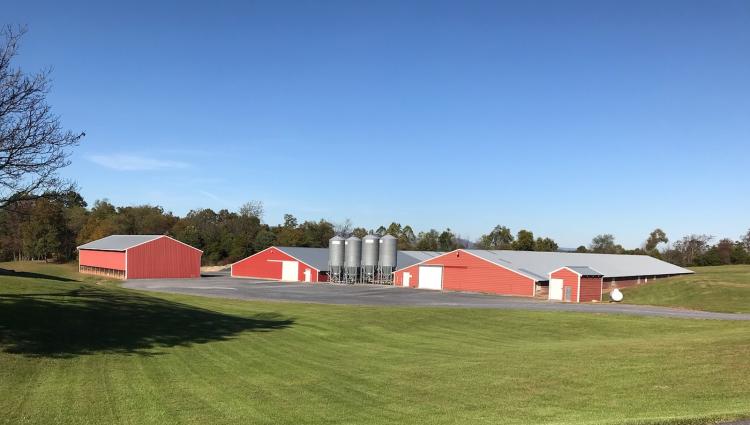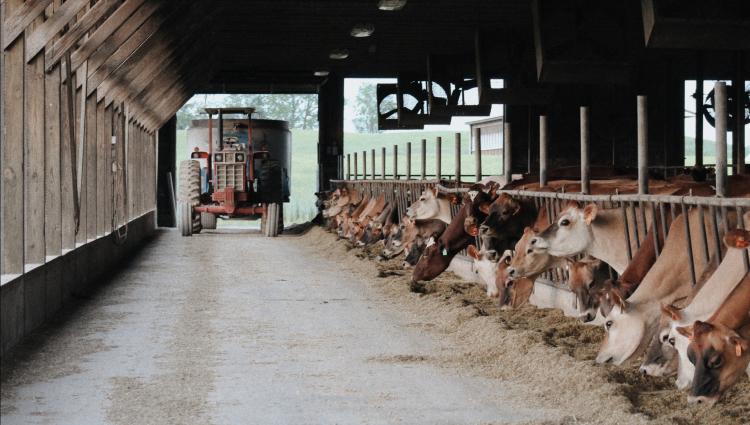Newsroom
Horizon Farm Credit Announces Strong 2024 Third Quarter Financial Results
Horizon Farm Credit sees growth in 2024 third quarter, announcing strong financial results. Net accruing loan volume for the first nine months of 2024 was $7.0 billion, an increase of 7.0% compared to the same 2023 period. Net interest income for the third quarter of 2024 was $49.8 million, a 17.6% increase from the same period in 2023. Net income for the quarter was $30.1 million, a 3.2% increase compared to the third quarter of 2023. The favorable impact of the 2024 third quarter results is principally related to increased loan volume.
Nonaccrual loans increased $1.2 million in the third quarter of 2024 to $29.2 million, compared to $28.0 million at December 31, 2023, and decreased $1.5 million compared to $30.7 million at September 30, 2023. The Association’s nonaccrual loans as a percentage of total loans decreased to 0.41% at the end of the third quarter of 2024 compared to 0.42% at the end of 2023 and compared to 0.48% at the end of the third quarter of 2023.
“The success we’ve seen in 2024, and especially the third quarter, is a direct result our of member-borrowers’ resilience,” said Tom Truitt, Horizon Farm Credit’s Chief Executive Officer. “Our mission is to support rural America with consistent and reliable credit that allows borrowers achieve their dreams. Horizon Farm Credit’s strong financial position reflects the accomplishments of our members, and we’re proud to support them in their journeys.”
Members’ equity as of September 30, 2024, totaled $1.3 billion — up 8.1% from December 31, 2023. Total Regulatory Capital Ratio was 15.68% as compared with the 10.5% minimum mandated by the Farm Credit Administration, the Association’s independent regulator. The Association paid a cash patronage distribution of $79.5 million to its member-borrowers in the first quarter of 2024.
For more information about the financial results and Horizon Farm Credit, click here.
Please enter a valid password to access this page:
Wrong password. Try again!Newsroom
Poultry Flock Ownership: What to Consider

By Nathan Briggs, Ag Relationship Manager
In today’s poultry industry, most growers operate under contracts with integrators, where the integrator owns the chickens, provides the feed, and handles the processing. However, some integrators, particularly in the laying industry, are beginning to offer options for growers to own all or a portion of their flock. While this arrangement allows growers to receive more revenue for their product, flock ownership also comes with increased responsibilities, risks, and costs.
To help determine whether the risks of flock ownership are worth the potential rewards, growers should carefully consider the following questions:
Key Questions to Consider Before Flock Ownership:
- Timing and Motivation:
- When did you start considering bird ownership?
- Why do you believe now is the right time to move forward?
- Industry Experience:
- Do you have prior experience in the poultry industry?
- Partnerships and Contracts:
- Are you seeking to partner with an integrator for bird or egg purchasing?
- Can you secure a reliable and long-term egg purchasing contract?
- Expert Guidance:
- Who will provide veterinary advice?
- Who will offer nutritional guidance?
- From whom will you purchase genetics lines?
- Financial Considerations:
- How will you cover upfront feed and pullet costs?
- Do you need a revolving line of credit for operating expenses?
- What is your exit strategy if the investment does not work out?
Starting any type of poultry operation is a significant investment. Poultry barns and fixtures are typically financed over 12 to 15 years. If a grower is considering flock ownership, they may also need financing for the birds, with the loan term generally matching the length of rotation. For laying birds, this term is typically 15 to 18 months. Additionally, since flock ownership means the grower is responsible for providing feed, a revolving line of credit may be necessary to finance feed and other operating expenses. It is expected that this line of credit should fully revolve with each flock rotation.
Maintaining appropriate levels of working capital is crucial for any poultry operation, but especially for those with flock ownership. Unexpected expenses can arise, making it essential for growers who own their birds to have cash readily available.
Flock ownership is a significant decision, with many opportunities and risks to weigh. If you are considering flock ownership, reach out to our team of experts at Horizon Farm Credit today to discuss your individual situation.
Please enter a valid password to access this page:
Wrong password. Try again!Crafting exceptional beers and spirits takes resources, dedication and true artistry. Whether you’re a seasoned crafter or an emerging business, our distillery and brewery loans are designed to help expand your operations, upgrade equipment, and purchase inputs and supplies needed to elevate your craft.
Beekeeping, also known as apiculture, plays a vital role in agriculture and ecosystem health by facilitating pollination and honey production. Whether you’re an experienced beekeeper aiming to expand your apiary or a newcomer, we can help you secure the financial support you need. We’re an experienced agriculture industry lender and can offer specialized apiculture loans tailored to meet your needs.
Newsroom
What Are the Requirements to Qualify for An Ag Loan?

While not drastically different from regular loans, there are some agriculture loan requirements that are specific to the farm and agribusiness industries. Requirements may vary from lender to lender, but here’s our breakdown of how to qualify for an agriculture loan.
Typical ag loan requirements for direct ownership loans
Direct ownership loans are designed to help farmers purchase or expand their farms or farm businesses. These loans provide assistance to farmers who have the necessary experience but lack the financial resources to buy land or make significant improvements to their existing operation. These agriculture loan requirements include:
- Be a U.S. citizen or permanent resident
- Have acceptable credit
- Demonstrate the ability to repay the loan
- Have legal capacity to incur the obligations of the loan
- Provide a feasible business plan
For FSA loans in particular, you also need to prove that you are unable to secure credit from a traditional financial institution and you need to own or operate a family-sized farm.
Operating loan requirements
Operating loans are essential for covering day-to-day expenses on the farm, including inputs and labor costs. These loans provide the necessary funds to ensure smooth operation and financial stability throughout the year, but they typically have an additional requirement of providing suitable collateral to secure the loan.
New and beginner farmer loans
Young and beginner farm loans are designed for individuals who are new to farming or have limited farming experience. These loans help aspiring farmers overcome financial barriers and establish a successful farming operation. Additional beginner agriculture loan requirements could include:
- Meeting the eligibility criteria for direct ownership loans
- Being a new/beginning farmer with 10 years or less of farming experience
- Participating in a borrower training or farm management program
At Horizon Farm Credit, the requirements for a new and beginner farm loan are a bit more flexible to include relaxed underwriting standards and access to an online ag business learning program called Ag Biz Masters.
Horizon Farm Credit loan requirements
These are general requirements and may vary slightly from lender to lender. It's always a good idea to check with your preferred lender for a list of their specific requirements before applying. At Farm Credit, some of the specifics we’ll ask for include:
- 20-30% down payment (some exceptions apply)
- Three years of tax returns
- Bank Statements
- Business Plan
- Balance Sheet
- Asset verifications like stocks, mutual funds, retirement accounts, etc.
- Pay stubs or YTD profit and loss statement
- Copy of your Driver’s License
Farm Credit is committed to helping you navigate the agriculture loan process and secure the loan that best fits your farming needs. From direct ownership loans to beginner farmer loans, we're here to make your farming goals a reality. So, don't hesitate to reach out, and let's cultivate your farming future together.
Please enter a valid password to access this page:
Wrong password. Try again!Newsroom
Maximize Your Dairy Profits: The Power of Dairy Revenue Protection

Opportunity is knocking, and it’s time to reach out and seize it. With the recent rebound in Class III milk prices, the outlook for milk futures is increasingly promising. Now is an ideal time to secure a milk price that exceeds your break-even point, extending as far as the next five quarters. But how? The answer lies in Dairy Revenue Protection.
Understanding Dairy Revenue Protection
Dairy Revenue Protection (DRP) is a revenue-based risk management tool that uses futures prices from the Chicago Mercantile Exchange (CME) for class pricing and Agricultural Marketing Service (AMS) formulas for component pricing. This tool allows producers to purchase price protection by quarter, by hundredweight, and either by class or component pricing for up to five quarters in advance.
Class III pricing is based on cheese products, while Class IV pricing is tied to butter and dry products. With class pricing, producers can manage their risk by diversifying across various dairy products. For instance, if the market for Class III declines while Class IV remains steady, as was observed after COVID-19, a producer can mitigate risk by splitting their endorsements between classes, making separate endorsements for Class III and Class IV.
Another approach is component pricing, which pools all products together—such as butter, cheese, dry whey, nonfat dry milk, butterfat, protein, other solids, and nonfat solids—into one pricing model.
How Endorsements Work
Endorsements can be secured at 80-95% of the price. For example, if the forecasted Class III price for the upcoming quarter is $20.00 per cwt., selecting 95% price protection would insure the price at $19.00 per cwt. If the price drops to $17.50 per cwt. during that quarter, the insured milk would receive an indemnity (payout) at a rate of $1.50 per cwt.
It’s important to note that milk can only be insured once under DRP. If 100,000 lbs. are produced, then no more than 100,000 lbs. can be insured. However, DRP offers an option to protect up to 1.5 times the milk’s guarantee. For instance, if 100,000 lbs. are produced, it can be insured with a 1.5 protection factor, effectively safeguarding 150,000 lbs. of production.
Seize the Opportunity
Milk prices are up, and opportunity is knocking. Our team of risk management specialists is ready to help you lock in a milk price that exceeds your break-even cost of production. Stability is just one call away—reach out to us today!
Please enter a valid password to access this page:
Wrong password. Try again!Newsroom
Covering Your Bases: Safeguard Your Winter Grains with Crop Insurance

Chevy Martin, Crop Insurance Agent
When reflecting on my son’s first T-ball game this year, the only word that comes to mind is "chaos." Half of the team was chasing after a ball slowly dribbling through the infield, while the other half was content playing in the dirt. The scene elicited laughter from every parent and grandparent, regardless of which team they supported. The young players were clearly having fun, but they had little understanding of where to stand or run. For them, covering the bases wasn't a priority (and with no one getting called out, it didn't need to be!).
In contrast, succeeding in agriculture is far from fun and games. Covering all your bases is essential. For anyone involved in production agriculture, one of the critical bases to cover is risk management. Much of the Mid-Atlantic region has faced significant drought this summer, and the impacts are expected to be evident during the fall harvest. With the right coverage, you can ensure that your finances will support the crucial operations needed to keep your farm running.
Looking ahead, beyond the fall harvest for corn and soybeans, it's important to consider the crops that will be planted next: winter wheat and barley. These small grains play a vital role in many diverse farm operations, yet they are often overlooked in risk management strategies. As input costs continue to rise and the grain markets grow more volatile due to global events, the importance of safeguarding your crops cannot be overstated. Weather patterns are shifting, and extreme conditions are becoming increasingly common. Now more than ever, it's crucial to assess and address the risks associated with every aspect of your operation. This fall, be sure to connect with your agent to get a quote for a new policy or to review your existing coverage to ensure it meets your current needs.
A wheat or barley policy can provide protection from various risks, including:
- Hail
- Frost/Freeze
- Excessive Moisture
- Wind
- Drought
- Naturally occurring fire
- Insects and Plant Disease
- Wildlife damage
- Quality loss from Vomitoxin
- Changes in harvest price from the projected price
The deadline to make changes to your wheat and barley policy is rapidly approaching. Be sure to speak with a crop insurance agent before September 30th to ensure all your bases are covered!
Please enter a valid password to access this page:
Wrong password. Try again!Our entry period is closed - thank you for your nominations!
Enter to Win a Harvest Meal
When your work is measured in acres and not hours, harvest season can be especially long for you, your family, and your farm. At Farm Credit, we appreciate your dedication to bringing in the harvest and feeding our communities. To show our thanks, we will be delivering 85 meals to local farmers in our footprint this season.
Newsroom
Unsung Heroes of Agriculture: The Impact and Importance of Perennial Crops

Joel Alsdorf, Crop Insurance Agent
Perennial crops are a vital part of the agricultural community and can sometimes be overlooked or taken for granted. These remarkable fruits, nuts, and berries positively impact the local communities in which they’re grown. The trees, vines, and bushes provide significant carbon sequestration, erosion control, nutrient retention, pollinator support, fiber, flavor, and beauty to everyday life. They are the lifeblood of many communities around the globe. Their infrastructure provides jobs, promotes healthy eating habits, and injects countless dollars into the local economy. Nearly every household in America likely benefits daily from some type of perennial product.
When envisioning perennials, one might picture rolling rows of vibrant foliage, feel the cool breeze rich with the spice of a million blooms, and imagine the aroma of ripening fruit in pastel hues cascading below curtains of emerald green. One might also think of the farmers who dedicate generations of lives to roadside stands, farmers markets, and diverse supermarket aisles.
How many consumers have ever asked themselves what would happen if these crops failed. How would that impact the farmers, the local economy, and their eating habits? Would there be missed educational opportunities for farm kids to bring innovative technology and science back to the farm? Perennials truly epitomize the concepts of symbiosis and sustainability.
Farmers understand what it takes to bring food to the table. They know how hard it is to navigate the variables and unpredictable circumstances producers face. There is always something competing for the nutrition they depend upon. As producers, they need every resource they can utilize to yield nutritious, affordable food while hoping to make a profit. Building intentional relationships of trust and substance is vital to achieving these goals.
Relationships with people who understand financial goals, accounting needs, and risk mitigation strategies can go a long way in supporting farmers in their areas of expertise. In an ever-changing world, planning for the next generation can feel like a daunting task. It is truly amazing for farmers to have a support network that understands how to work hard together, enjoys helping solve problems, and takes pride in their success. Horizon Farm Credit would like to thank farmers for their dedication and perseverance in providing for our communities.
Farm Credit’s crop insurance agents are knowledgeable and prepared to help discuss coverage options for your unsung heroes: perennials. Contact us today at 888.339.3334 or learn more here.
Please enter a valid password to access this page:
Wrong password. Try again!Newsroom
Payroll Services with Farm Credit

Written by Jessie Savidge, Accounting Officer
At Farm Credit, we understand the complexities and responsibilities that come with managing payroll. From ensuring timely tax deposits to handling deductions and compliance, we’re here to simplify your payroll process so you can focus on what matters most – growing your business.
Managing payroll involves more than just issuing checks. It’s about navigating regulations, deadlines, and penalties, while being accurate and timely. One of the most common challenges our clients face is compliance with tax regulations and deadlines. Missing deadlines for payroll tax deposits can lead to penalties and interest. Our team helps mitigate these risks by ensuring timely filings and deposits, keeping your business in good standing with regulatory requirements.
Another critical aspect is managing deductions and wage garnishments accurately. Our payroll services include support for handling these aspects, making sure that all legal requirements are met, and employees receive accurate compensation according to their deductions.
We also recognize that technology limitations can hinder payroll efficiency. Some systems may not support direct deposit or lack the flexibility needed for customized payroll needs. Farm Credit offers comprehensive in-house support, providing accurate hour tracking and customized payroll services tailored to your needs.
Our expertise extends beyond basic payroll processing to include tax obligations. We manage quarterly filings and deposit frequencies, minimizing the risk of penalties and interest for late or incorrect filings. We also handle tax returns and tax planning. Our services are customized to your needs. We provide one on one help to guide and build a plan for you.
Flexibility is key to our service offering and our payroll solutions are adaptable to your business cycle and growth trajectory. By partnering with Farm Credit, you gain peace of mind knowing that any penalties or incorrect filings fall directly to us.
Our payroll team is dedicated to providing personalized service and is prepared to help discuss solutions for you. Ready to simplify your payroll process? Contact us today at payroll@horizonfc.com.